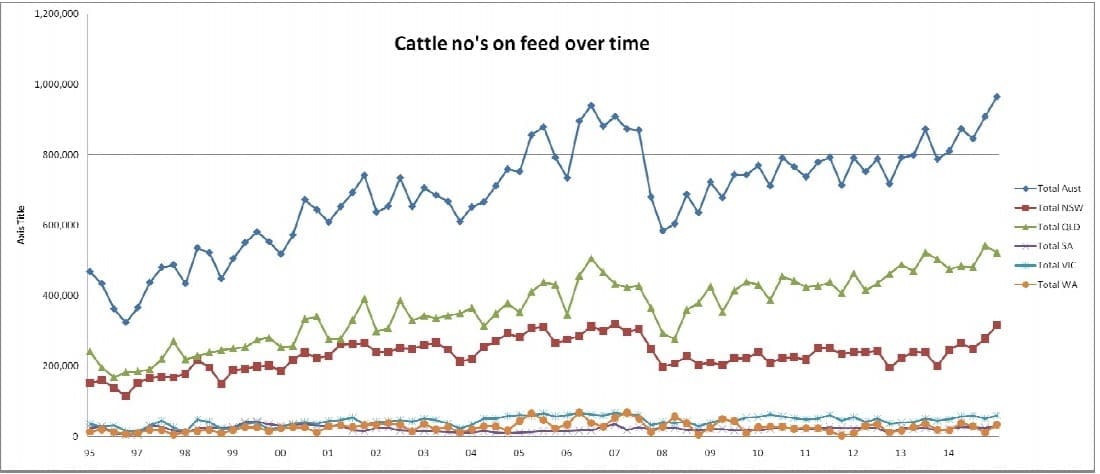CATTLE numbers in Australian feedlots rose to record levels at the end of December, but deliberately-imposed lags in the collection and distribution of data have failed to capture the most recent downwards trend in cattle feeding since recent rain.
The quarterly industry survey released this morning for the quarter ended December 30 showed a six percent increase in numbers on feed across Australia to 965,000 head, eclipsing the previous record of 940,000 head set back in June 2006 quarter.
That result was heavily influenced by drought across Eastern Australia during the second half of last year, but widespread beneficial rain across the region since late December has since seen many feedlots pull back on numbers.
It won’t be until the next March quarterly survey, not likely to be released by MLA/ALFA until around mid-May, that the current trend in lotfeeding numbers becomes evident.
Certainly quite a number of Queensland lotfeeders Beef Central has spoken to in the past month have reported vacant pens, and numbers in decline. Anecdotally, reductions of 10-20pc in numbers appear reasonably common, especially among custom-feeders.
That’s a result of the large body of feed now present in many grazing paddocks, and the explosion in feeder steer and heifer prices since the rain arrived.
Australian Lot Feeders Association president Don Mackay said the survey results largely reflected the dry conditions in many areas late last year which made it difficult for grassfed cattle operators to sustain numbers.
“The result also reflected the ongoing strong demand for Australian beef overseas and processors’ desire to shore-up cattle requirements during the traditionally quiet (and potentially wet) January period,” he said.
Increases in cattle numbers were witnessed in the December quarter in all feedlot states, with the exception of Queensland (back 20,000 head on September), which was already effectively at operational capacity.
NSW numbers on feed jumped almost 40,000 head between September and December, to 315,000 head (up 70,000 head on a year earlier), while Victoria lifted 9000 head to 60,000 head over the same period (up 11,000 head year-on-year).
Utilisation of available feedlot capacity last quarter reached 84pc across Australia, also a record, exceeding the previous mark of 83pc set in 2006. Queensland’s occupancy reached 86pc last quarter, NSW 88pc and Victoria 79pc. Pen cleaning, maintenance and variations in individual pen occupancy make it operationally difficult to achieve utilisation levels much higher than these figures.
Industry feeding capacity also showed a modest rise over the past 12 months, lifting 10,000 head to 1.142 million in December, year-on-year.
Yearling steers (330-400kg, C2) trended dearer for the December quarter with a 15pc rise year-on-year, averaging 198c/kg liveweight nationally.
Average December quarter grain prices were mixed, with wheat on the Darling Downs back 1pc on the previous quarter but up 4pc year-on-year while Riverina barley was 23pc dearer than the same period last year, averaging $258/tonne.
Meat & Livestock Australia’s market information manager Ben Thomas said grainfed beef exports for 2014 totalled 231,000t, up 10pc on 2013 levels on the back of a decline in world cattle inventories and a lower Australian dollar.
Grain fed beef exports results for 2014 were mixed with Japan, Korea and the EU up 12pc (to 130,000t), 15pc (to 33,000t) and 43pc (to 16,500t) respectively while China and the Middle East were down 35pc (to 13,400t) and 13pc (to 9087t).

